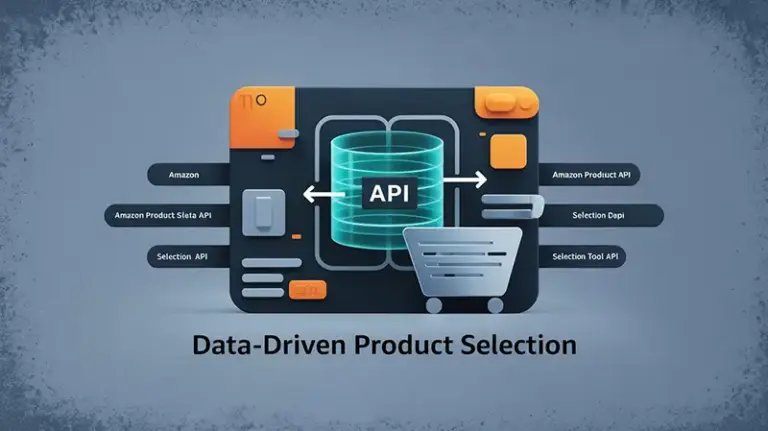In the increasingly fierce competition on the Amazon platform, product selection has transformed from intuition-driven to data science. However, when you’re manually browsing Amazon pages late at night, trying to discover the next potential product, have you ever wondered: why are we still using the most inefficient methods to make the most important business decisions?
The Data Dilemma in Amazon Product Selection: Visible Pain Points
When it comes to Amazon product selection, almost every seller has the same experience: jumping between countless product pages, copying and pasting data into Excel spreadsheets, and then making decisions that could affect hundreds of thousands of dollars in investment based on incomplete information. This approach is not only inefficient but, more dangerously, may cause you to miss the best business opportunities.
What’s the reality? Most Amazon sellers rely on third-party tools like Jungle Scout and Helium 10 to obtain product data and then analyze it in spreadsheets. On the surface, this method seems “scientific,” but a deeper look reveals endless problems.
The most direct issue is data lag. The “hot-selling” data you see today may well reflect market conditions from last week or even earlier. On a rapidly changing platform like Amazon, a delay of a few days can be enough to make you miss the optimal time to enter a niche market. When you formulate product selection strategies based on outdated data, the market landscape may have completely changed.
Even more critical is the problem of incomplete data. Traditional tools usually only provide superficial information such as basic sales rankings, price ranges, and the number of reviews. However, it’s difficult to obtain complete and accurate information on the deep-seated data that truly determines a product’s success or failure—such as competitors’ PPC advertising strategies, the emotional tendency of user reviews, and seasonal sales fluctuation patterns.
When the business scale expands, this manual analysis method becomes completely unfeasible. Imagine if you need to analyze data for 1,000 ASINs. Using traditional methods, it might take a team months of work, while the market would have changed several times over.
Why Are Traditional Amazon Product Selection Tools Insufficient?
Let’s delve into the fundamental limitations of existing Amazon product selection tools. The problem with these tools isn’t weak functionality but that the constraints of their business models prevent them from truly meeting the needs of professional sellers with large-scale requirements.
Take mainstream tools, for example. Their API services are usually priced independently, with high costs and strict limits on the number of calls. It’s like giving you a supercomputer but only allowing you to turn it on for two hours a day. When you need large quantities of Amazon product data to support decisions, this limitation becomes a bottleneck for development.
A deeper issue is the conflict between standardization and personalized needs. Every Amazon seller has a different product selection logic: some focus on high-frequency, low-price products, some delve into high-value niche markets, some pursue rapid turnover, and some focus on brand building. Standardized tools are like assembly-line products—usable but never fully tailored to your specific needs.
There’s also a severely underestimated problem of data accuracy. To serve a broader user base, traditional tools often adopt relatively粗放 methods in data collection. Especially in collecting Amazon’s sponsored ads data, ordinary tools may only capture 60-70% of real ad impressions, and the missing 30-40% often contains the most valuable competitive intelligence.
Technological Reconstruction of Amazon Product Selection: The Revolutionary Significance of Amazon Product Selection API
When we talk about Amazon Product Selection API, we’re essentially discussing a new paradigm of Amazon data acquisition. This is not just a tool iteration but a business thinking upgrade.
The core value of Amazon Product Selection Data API is transforming data acquisition from “standardized supply” to “customized demand.” In the traditional model, you can only passively accept the data dimensions that tool providers consider important, while the API model allows you to accurately obtain the required information according to your own Amazon product selection logic.
Consider a practical scenario: you want to analyze the PPC advertising competition for all products in the Amazon home category priced between $30-$80, with a BSR ranking in the top 1,000, more than 500 reviews, and a rating of 4.0 or higher. Traditional tools might require you to perform dozens of manual filtering operations, but with Amazon Product Data API, this can be accomplished with a single precise call.
More crucially, the API approach supports real-time Amazon data acquisition. The Amazon market changes rapidly—today’s blue ocean may become a red ocean tomorrow. With Amazon Product Selection Tool API, you can set up automated monitoring tasks to achieve hourly or even minute-level data updates, ensuring that product selection decisions are based on the latest market conditions.
Pangolin Scrape API: Redefining Amazon Data Acquisition Standards
Among numerous technical solutions, Pangolin Scrape API represents the professional level in the field of Amazon data collection. It’s not just a data scraping tool but a complete data infrastructure specifically designed for the Amazon ecosystem.
In terms of technical indicators, Pangolin’s advantages in Amazon data collection are extremely obvious. In terms of data real-time performance, updates can be as fast as minute-level, which in the Amazon product selection scenario means you can discover market opportunities first. When a product suddenly experiences a surge in sales, you can immediately obtain its complete data portrait instead of waiting for the scheduled updates of traditional tools.
Even more impressive is its Amazon data processing scale. Supporting the collection capacity of tens of millions of Amazon pages per day means that even the largest-scale Amazon sellers can achieve full-category, full-market data coverage through this system. This scale advantage is not just a quantitative breakthrough but, more importantly, provides the possibility for in-depth Amazon market analysis.
In terms of Amazon data quality, Pangolin leads the industry in key areas. Especially in Amazon sponsored ads data collection, a 98% collection success rate is almost perfect. It’s important to note that Amazon’s advertising algorithm is a highly complex black-box system, and achieving such high collection accuracy requires an in-depth understanding of Amazon’s platform mechanisms and strong technical capabilities.
Another core value of Amazon Commodity Selection Interface is its in-depth customization capability. Pangolin supports obtaining specific dimensions of Amazon data through precise parameter control. For example, you can systematically traverse all products under a certain Amazon primary category, with a product discovery rate of over 50%. This is an extremely scarce capability for large sellers who need to build a complete Amazon market map.
Who Needs Amazon Product Selection API the Most?
Not all Amazon sellers need API-level data solutions. This technical solution is most suitable for sellers or service providers who have a certain scale, are equipped with technical teams, and have personalized Amazon data analysis needs.
Specifically, if you meet the following characteristics, then Amazon Product Selection API may be your best choice:
- Your Amazon business is no longer satisfied with the standardized data provided by existing tools and hopes to obtain personalized Amazon market information according to your own product selection logic;
- Your SKU scale has reached a level that manual analysis can’t handle, requiring an automated Amazon data processing process;
- You have a technical team that can perform API integration and secondary development processing of Amazon data;
- You want to get rid of dependence on third-party Amazon tools and establish your own data competitive advantage.
The typical problem faced by such users is: existing Amazon analysis tools are highly homogeneous, and everyone uses similar data sources and analysis methods, leading to highly overlapping product selection results, which eventually fall into a vicious cycle of price wars and homogeneous competition. Through customized Amazon data acquisition and analysis, you can discover niche opportunities that others don’t notice and achieve differentiated competition.
Practical Analysis: How API Transforms the Amazon Product Selection Process
Let’s look at specific Amazon product selection scenarios to see how API changes traditional workflows.
Scenario 1: Amazon New Category Entry Decision
Traditional way: Spend weeks manually researching the target Amazon category, piece together data through multiple tools, and finally come up with a possibly inaccurate market analysis report.
API way: Obtain basic information of all products in the target category through a single Amazon Product Selection Data API call, then obtain detailed Amazon data for each product through batch calls, including sales trends, price fluctuations, review sentiment analysis, etc. The entire Amazon market analysis process may take only a few hours, and the completeness and accuracy of the data are far superior to manual collection.
Scenario 2: Amazon Competitor Monitoring and Strategy Adjustment
Traditional way: Manually record price and sales changes of major Amazon competitors and maintain complex Excel tracking spreadsheets.
API way: Set up automated Amazon monitoring tasks to track competitors’ price adjustments, promotional activities, and advertising changes in real-time. When important Amazon market changes are detected, automatic alerts are sent to help you quickly adjust your competitive strategy.
Scenario 3: Amazon Advertising Campaign Optimization
Traditional way: Adjust keywords and bidding strategies mainly based on experience, relying on limited Amazon advertising data.
API way: Through high-precision Amazon sponsored ads data collection, in-depth analysis of the competitive landscape under different keywords, insight into the advertising strategies of top Amazon sellers, and formulate more accurate advertising plans.
The Future Vision of Amazon Product Selection Driven by Data
With the deep integration of AI technology and Amazon data analysis, future Amazon product selection will become more intelligent and automated. Amazon Product Selection API is not just a current data acquisition tool but also the data foundation for future AI-driven Amazon product selection systems.
Imagine such an Amazon product selection scenario: your AI assistant automatically analyzes global Amazon market data every day, identifies potential product opportunities, evaluates supply chain feasibility, calculates expected Amazon sales ROI, and even automatically executes purchasing decisions. This fully automated Amazon product selection process is not a distant vision but a reality that is rapidly approaching.
However, to achieve such Amazon product selection intelligence, the premise is to have high-quality, large-scale Amazon data support. That’s why investing in API-level Amazon data infrastructure is so important now—you’re not just solving current product selection problems but also preparing for the future intelligent transformation of your Amazon business.
Investment Return Analysis: Is Amazon Product Selection API Worth It?
Many Amazon sellers, when considering whether to adopt Amazon Product Selection API, first consider the cost issue. It’s true that compared to using off-the-shelf Amazon analysis tools, the API solution requires more technical investment and learning costs.
But we need to comprehensively evaluate this issue from the perspective of Amazon business ROI. Traditional Amazon tools seem to have lower costs, but they actually have a lot of hidden costs: opportunity costs due to insufficiently timely Amazon data, efficiency losses due to unmet personalized needs, tool switching costs during scale expansion, and so on.
More importantly, Amazon data capabilities are becoming the core competitiveness of platform sellers. In an environment where Amazon’s homogeneous competition is becoming increasingly fierce, whoever can obtain and analyze Amazon market data faster and more accurately will have an advantage in the competition. From this perspective, investing in professional Amazon data infrastructure is not a cost expenditure but a strategic investment.
Pangolin Scrape API also has obvious cost advantages in Amazon data acquisition. Due to optimized technical architecture, the marginal cost is low, which is usually more cost-effective than building an in-house Amazon crawler team. Moreover, as the scale of Amazon data usage expands, the unit data acquisition cost will further decrease.
Avoiding Amazon Product Selection API Implementation Pitfalls
In the actual deployment of Amazon Product Selection API, many enterprises will encounter some common problems. Understanding these potential pitfalls in advance can help you more smoothly complete the technical upgrade of Amazon data analysis.
First is the issue of Amazon data digestion capability. API can provide massive amounts of Amazon data, but if your analysis capability can’t keep up, no matter how much data there is, it’s just a pile of numbers. It’s recommended that before using Amazon Product Selection API, you first sort out your own Amazon business analysis needs and product selection logic to avoid being overwhelmed by data.
Second is the risk of technical dependence. Although Amazon Product Selection API provides greater flexibility, it also means more technical maintenance work. Ensure that your team has sufficient technical capabilities to handle Amazon data, or choose a professional service provider like Pangolin that offers comprehensive technical support.
Finally, there’s the issue of compliance. When conducting large-scale Amazon data collection, it’s essential to comply with the platform’s terms of use and relevant laws and regulations. Professional Amazon data API service providers usually have more experience and more comprehensive compliance guarantees in this regard.
Conclusion: Embracing the Data-Driven Future of Amazon Product Selection
Returning to the core question at the beginning of the article: why are we still using the most inefficient methods to make the most important business decisions?
The answer is actually clear: because we haven’t found a better Amazon product selection method. But now, Amazon Product Selection API provides us with a new possibility. It’s not just an upgrade of tools but a fundamental change in the way of thinking about Amazon product selection.
In this Amazon data-driven era, having stronger data acquisition and processing capabilities means having a stronger competitive advantage in the Amazon market. Whether it’s Pangolin Scrape API or other similar Amazon data solutions, the key is to take action and make changes.
Because on Amazon, a platform full of variables and opportunities, the biggest risk is not the possibility of failure when trying new methods but sticking to traditional ways and missing Amazon market opportunities. When your competitors have already started using API-level Amazon data solutions, and you’re still manually organizing product information spreadsheets, this in itself means a competitive disadvantage.
The future of Amazon product selection is bound to be intelligent, automated, and personalized. And the technical foundation of this future is our investment decisions in Amazon data infrastructure today. Choosing Amazon Product Selection API is not just choosing a data tool but also choosing a strategic path for future Amazon business development.




